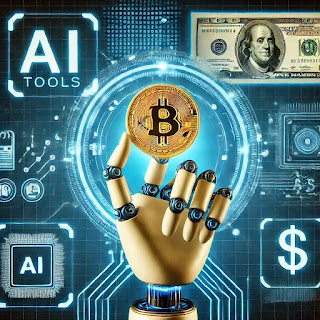AI and the Future of Human-AI Collaboration: Will AI Replace Jobs or Enhance Them? 🤖💡
AI and the Future of Human-AI Collaboration: Will AI Replace Jobs or Enhance Them? 🤖💡
The advent of Artificial Intelligence (AI) has sparked intense debates across industries, governments, and societies. While some fear that AI will replace human jobs, others believe it has the potential to enhance human capabilities and create new opportunities. As AI technology continues to advance, the question remains: Will AI replace jobs, or will it enhance them?
In this blog, we’ll explore how AI is reshaping the workforce, the myths and realities surrounding its impact, and how human-AI collaboration is poised to shape the future of work.
The Rise of AI in the Workplace 🚀
Over the past decade, AI has made significant strides in automating tasks that were once the sole responsibility of humans. From self-checkout kiosks at grocery stores to chatbots handling customer service inquiries, AI is becoming an integral part of our daily lives. But the question persists: Is AI a threat to human jobs, or is it a tool for greater productivity?
AI excels at performing tasks that are repetitive, data-driven, and predictable. This includes everything from managing inventory to data entry, quality control, and even making real-time decisions in complex environments like finance, healthcare, and manufacturing. As AI takes over these routine tasks, it frees up human workers to focus on more creative, strategic, and emotional intelligence-based roles.
AI: A Tool for Enhancement, Not Replacement 🛠
While AI can perform certain tasks with greater speed and accuracy than humans, it is important to understand that AI isn’t here to replace humans; it’s here to augment human abilities. Let’s break this down further:
1. Automation of Repetitive Tasks 🔄
AI can automate tedious, repetitive tasks that take up a large chunk of human workers' time. For example, AI-driven tools can process data, schedule appointments, or handle customer inquiries—all of which can be time-consuming for humans. By automating these tasks, employees can focus on higher-level decision-making, problem-solving, and creative thinking.
Rather than replacing human workers, AI enables collaboration. In fields like finance, marketing, and human resources, AI can analyze trends, forecast outcomes, and make suggestions, but it’s the human who has the final say in implementing strategies.
Example: In human resources, AI can screen resumes and suggest the best candidates, but the hiring manager still conducts interviews to assess cultural fit and soft skills.
The Future of Human-AI Collaboration 🌍
As AI continues to evolve, the future of work will likely see humans and AI working together to tackle complex challenges. The collaboration between AI and humans will lead to the emergence of new job roles and industries that we can’t even imagine today. Here’s how the future might look
1. New Job Roles and Opportunities 🌱
AI will not just eliminate jobs; it will create new opportunities. For example, roles in AI ethics, data science, and AI maintenance are already emerging as AI technology becomes more integrated into business operations. There will be a growing need for professionals who can train, manage, and fine-tune AI systems.
Example: As AI becomes more prevalent in autonomous vehicles, new roles such as AI trainers, safety officers, and system testers will be in high demand.
2. Upskilling and Reskilling the Workforce 📚
For AI to truly enhance the workforce, employees must be prepared to work alongside AI. This means upskilling or reskilling the workforce to understand and leverage AI tools.
Training programs that teach employees how to use AI in their daily tasks will be essential in ensuring a smooth transition to a more AI-integrated workplace. This opens the door for employees to evolve in their careers and take on roles that were previously unimaginable.
Example: AI-based virtual training platforms are already being used to provide employees with the necessary skills to work with AI systems, whether in design, engineering, or customer service.
3. Human-AI Collaboration in Complex Problem Solving 🧠
The future of AI is not just about replacing jobs but about solving complex problems together. AI’s ability to process vast amounts of data and recognize patterns will complement human intuition, creativity, and ethical considerations. Together, AI and humans can tackle some of the world’s most pressing challenges, from climate change and disease prevention to space exploration and economic development.
Example: In medical research, AI can help scientists identify new drug compounds, while researchers and doctors use their expertise to develop personalized treatments for patients.
Conclusion: Embracing AI as a Partner, Not a Threat 🤝
The question isn’t whether AI will replace jobs, but how it will change the nature of work. The future of AI lies in human-AI collaboration – a partnership where both humans and machines bring their unique strengths to the table.
Rather than fearing AI, we should embrace it as a tool that can augment our abilities, free us from repetitive tasks, and help us make more informed decisions. AI isn’t here to replace us; it’s here to empower us. The key to success in the AI-powered world of tomorrow lies in collaboration, adaptation, and a commitment to continuous learning.
Are you ready to collaborate with AI and unlock new possibilities in your career? The future of work is exciting, and it’s just getting started. 🚀
Final Thoughts 🌟
As AI continues to evolve, businesses, workers, and governments must work together to ensure that AI enhances human lives and careers. The future is bright for those willing to adapt, learn, and embrace the power of human-AI collaboration.

.jpeg)



Comments
Post a Comment
Your feedback is appreciated. Share your comments below!
Be respectful and kind while commenting. Thanks for participating!